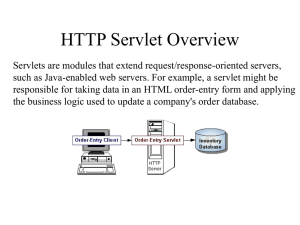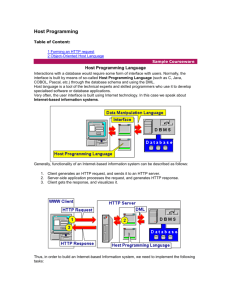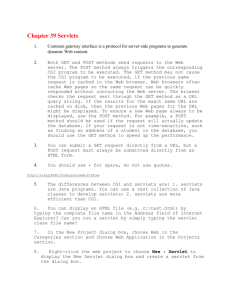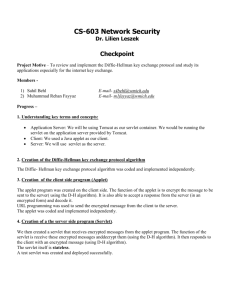Java Servlets
advertisement
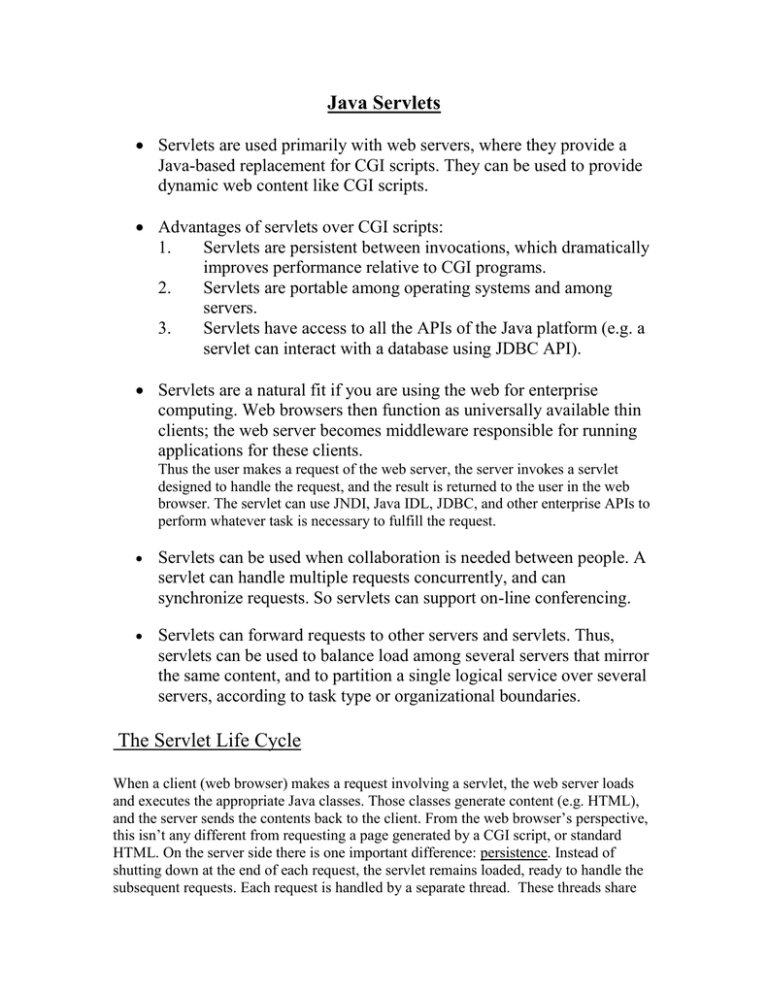
Java Servlets
Servlets are used primarily with web servers, where they provide a
Java-based replacement for CGI scripts. They can be used to provide
dynamic web content like CGI scripts.
Advantages of servlets over CGI scripts:
1.
Servlets are persistent between invocations, which dramatically
improves performance relative to CGI programs.
2.
Servlets are portable among operating systems and among
servers.
3.
Servlets have access to all the APIs of the Java platform (e.g. a
servlet can interact with a database using JDBC API).
Servlets are a natural fit if you are using the web for enterprise
computing. Web browsers then function as universally available thin
clients; the web server becomes middleware responsible for running
applications for these clients.
Thus the user makes a request of the web server, the server invokes a servlet
designed to handle the request, and the result is returned to the user in the web
browser. The servlet can use JNDI, Java IDL, JDBC, and other enterprise APIs to
perform whatever task is necessary to fulfill the request.
Servlets can be used when collaboration is needed between people. A
servlet can handle multiple requests concurrently, and can
synchronize requests. So servlets can support on-line conferencing.
Servlets can forward requests to other servers and servlets. Thus,
servlets can be used to balance load among several servers that mirror
the same content, and to partition a single logical service over several
servers, according to task type or organizational boundaries.
The Servlet Life Cycle
When a client (web browser) makes a request involving a servlet, the web server loads
and executes the appropriate Java classes. Those classes generate content (e.g. HTML),
and the server sends the contents back to the client. From the web browser’s perspective,
this isn’t any different from requesting a page generated by a CGI script, or standard
HTML. On the server side there is one important difference: persistence. Instead of
shutting down at the end of each request, the servlet remains loaded, ready to handle the
subsequent requests. Each request is handled by a separate thread. These threads share
code and data (instance vars). So try to avoid using instance vars, else be sure to use them
in synchronized blocks.
The request processing time for a servlet can vary, but is typically
quite fast when compared to a similar CGI program. The advantage in
the servlet is that you incur the most of the startup overhead only
once.
When a servlet loads, its init() method is called. You can use init() to
create I/O intensive resources, such as database connections, for use
across multiple invocations. If you have a high-traffic site, the
performance benefits can be quite dramatic.
Instead of creating thousands of database connections, the servlet needs to create a
connection only once.
The servlet’s destroy() method can clean up resources when the server
shuts down.
Because servlets are persistent, you can eliminate a lot of filesystem and/or database
accesses altogether. E.g., to implement a page counter, you can simply store a number in
a static variable, rather than consult a file (or database) for every request. Thus you need
to read and write to disk only occasionally to save state.
Since a servlet remains active, it can perform other tasks when it is not servicing client
request, such as running a background thread (where clients connect to the servlet to view
the result) or even acting as an RMI host, enabling a single servlet to handle connections
from mutiple types of clients. E.g., a servlet that accepts transactions from both an HTML
form and an applet using RMI.
Servlet Basics
The Servlet API consists of two packages, javax.servlet, and
javax.servlet.http.
The javax is there because servlets are a standard extension to Java, rather than a
mandatory part of the API. Thus JVM developers are not required to include classes
for them in their Java development and execution environments.
Sun has kept the distribution of the servlets API separate from the
Java 2 platform because the Servlet API is evolving much faster than
the core Java SDK. You can find the Java Servlet Development Kit
(JSDK) at http://java.sun.com/products/servlet/.
The JSDK includes the necessary servlet classes and a small
servletrunner application for development and testing.
HTTP Servlets
The HttpServlet class is an extension of GenericServlet class that
includes methods for handling HTTP specific data. HttpServlet
defines a number of methods, such as doGet(), and doPost(), to handle
particular types of HTTP requests (GET, POST, etc.). These methods
are called by the default implementation of the service() method,
which figures out the kind of request being made and then invokes the
appropriate method. (service() is defined in GenericServlet class).
Example 1:
import javax.servlet.*;
import javax.servlet.http.*;
import java.io.*;
public class HelloWorldServlet extends HttpServlet {
public void doGet(HttpServletRequest req, HttpServletResponse resp) throws
ServletException, IOException {
resp.setContentType(“text/html”);
PrintWriter out = resp.getWriter();
out.println(“<HTML>”);
out.println(“<HEAD><TITLE>Have you seen this
before?</TITLE></HEAD>”);
out.println(“<BODY><H1>Hello World!</H1></BODY></HTML>”);
}
}
The doGet() method is called whenever anyone requests a URL that points to this
servlet. The servlet is installed in the servlets directory (this is similar to the cgi-bin
directory for CGI programs), and its URL is http://site:8080/servlet/HelloWorldServlet.
The doGet() method is actually called by the default service() method of HttpServlet.
The service() method is called by the web server when a request is made of
HelloWorldServlet; the method determines what kind of HTTP request is being made
and dispatches the request to the appropriate doXXX() method (in this case, doGet()).
doGet() is passed two objects, HttpServletRequest ,and HttpServletResponse, that
contain information about the request and provide a mechanism for the servlet to
provide a response, respectively.
Example 2:
This example deals with forms and dynamic HTML.
The HTML form that calls the servlet using a GET request is as follows:
<HTML>
<HEAD><TITLE> Greetings Form</TITLE></HEAD>
<BODY>
<FORM METHOD=GET ACTION=”/servlet/HelloServlet”>
What is your name?
<INPUT TYPE=TEXT NAME=username SIZE=20>
<INPUT TYPE=SUBMIT VALUE=”Introduce Yourself”>
</FORM>
</BODY>
</HTML>
The form submits a variable named username to the URL /servlet/HelloServlet. The
servlet is as follows:
import javax.servlet.*;
import javax.servlet.http.*;
import java.io.*;
public class HelloServlet extends HttpServlet {
public void doGet(HttpServletRequest req, HttpServletResponse resp) throws
ServletException, IOException {
resp.setContentType(“text/html”);
PrintWriter out = resp.getWriter();
out.println(“<HTML>”);
out.println(“<HEAD><TITLE>Finally, interaction!</TITLE></HEAD>”);
out.println(“<BODY><H1>Hello,” + req.getParameter(“username”) +
“!</H1>” );
out.println(</BODY></HTML>”);
}
}
The getParameter() method of HttpServletRequest is used to retrieve the value of the
form variable. When a server calls a servlet, it can also pass a set of request parameters.
The POST request
The POST request is designed for posting information to the server,
although in practice it is also used for long parameterized requests and
larger forms, to get around limitations on the length of URLs. The
doPost() method is the corresponding method for POST requests.
If your servlet is performing database updates, charging a credit card,
or doing anything that takes an explicit client action, you should make
sure that this activity is happening in a doPost() method.
This is because POST requests are not idempotent, which means that they are not
safely repeatable, and web browsers treat them specially. E.g. a browser cannot
bookmark them. GET requests are idempotent, so they can safely be bookmarked,
and a browser is free to issue the request repeatedly (say to get some information
from the web server) without necessarily consulting the user. Hence it is not
appropriate to charge a credit card in a GET method!
To create a servlet that can handle POST requests, you need to override the default
doPost() method from HttpServlet and implement the necessary functionality. If
necessary, your application can implement different code in doPost() and doGet().
For instance, the doGet() method might display a postable data entry form that the
doPost() method processes. doPost() can even call doGet() at the end to display the
form again.
Servlet Responses
In the case of an Http servlet, the response can include three
components: a status code, any number of HTTP headers, and a
response body.
You use setContentType() method of the response object passed into
the servlet to set the type of the response. Examples include
“text/html” for text, “image/gif” for returning a GIF file from the
database, and “application/pdf” for Adobe Acrobat files.
ServletResponse and HttpServletResponse each define two methods
for producing output streams, getOutputStream() and getWriter(). The
former returns a ServletOutputStream that can be used for text or
binary data. The latter returns a java.io.PrintWriter object used for
text data.
You can use setStatus() or sendError() method to specify the status
code sent back to the server. Examples include, 200 (“OK”), 404
(“Not Found”) etc. The sendRedirect() method allows you to issue a
page redirect. Calling this sets the Location header to the specified
location and uses the appropriate status code for a redirect.
Servlet Requests
When a servlet is asked to handle a request, it typically needs
specific information about the request so that it can process the
request appropriately. For example, a servlet may need to find out
about the actual user who is accessing the servlet, for
authentication purposes.
ServletRequest and ServletRequest provide these methods.
Examples include getProtocol() (protocol used by request),
getRemoteHost() (client host name), getServerName() (name of the
web server), getServerPort() (port number the web server listens
at), getParameter() (access to request parameters as form
variables), and getParameterValues() (returns an array of strings
that contains all the values for a particular parameter).
Example 3:
This servlet requests information to restrict access.
import javax.servlet.*;
import javax.servlet.http.*;
import java.io.*;
public class SecureRequestServlet extends HttpServlet {
public void doGet(HttpServletRequest req, HttpServletResponse resp) throws
ServletException, IOException {
resp.setContentType(“text/html”);
PrintWriter out = resp.getWriter();
out.println(“<HTML>”);
out.println(“<HEAD><TITLE>Semi-Secure Request</TITLE></HEAD>”);
out.println(“<BODY>”);
String remoteHost = req.getRemoteHost();
String scheme = req.getScheme();
String authType = req.getAuthType();
if((remoteHost == null) || (scheme == null) || (authType == null)) {
out.println(“Request information was not available”);
return;
}
// look for a secure HTTP connection from a .gov host using Digest style /
//authentication
if(scheme.equalsIgnoreCase(“https”) && remoteHost.endsWith(“.gov”) &&
authType.equals(“Digest”)) {
out.println(“Special, secret information”);
}
else {
out.println(“You are not authorized to read this information”);
}
out.println(“</BODY></HTML>”);
}
}
Error Handling
If the error is part of a servlet’s normal operation, such as when a user
forgets to fill in a required form field, then write an error message to
the servlet’s output stream.
If the error is a standard HTTP error, use the sendError() method of
HttpServletResponse to tell the server to send a standard error status
code.
E.g. if a file was not found,
resp.sendError(HttpServletResponse.SC_NOT_FOUND);
Example 4:
This servlet serves HTML files.
import javax.servlet.*;
import javax.servlet.http.*;
import java.io.*;
public class FileServlet extends HttpServlet {
public void doGet(HttpServletRequest req, HttpServletResponse resp) throws
ServletException, IOException {
File r;
FileReader fr;
BufferedReader br;
try {
r = new File(req.getParameter(“filename”);
fr = new FileReader(r);
br = new BufferedReader(fr);
if (!r.isFile()) {
resp.sendError(resp.SC_NOT_FOUND);
return;
}
}
catch (FileNotFoundException e) {
resp.sendError(resp.SC_NOT_FOUND);
return;
}
catch (SecurityException se) { //Be unavailable permanently
throw(new UnavailableException(this, “Servlet lacks appropriate
privileges”));
}
resp.setContentType(“text/html”);
PrintWriter out = resp.getWriter();
String text;
while ((text = br.readLine()) != null)
out.println(text);
br.close();
}
}
Servlet Initialization
When a server loads a servlet for the first time, it calls the servlet’s init() method. In
its default implementation, init() handles some basic housekeeping, but a servlet can
override the method to perform other tasks. This includes performing I/O intensive tasks
such as opening a database connection. You can also create threads in init() to perform
other tasks such as pinging other machines on the network to monitor the status of these
machines. When an actual request occurs, the service methods can use the resources
created in init(). The default init() is not a do-nothing method. You must call always call
super.init() as the first action in your own init() routines.
The server passes the init() method a ServletConfig object. This object encapsulates
the servlet initialization parameters, which are accessed via the getInitParameter() and
getInitParameterNames() methods. GenericServlet and HttpServlet both implement the
ServletConfig interface, so these methods are always available in a servlet. Consult your
server documentation on how to set the initialization parameters.
Each servlet also has a destroy() method that can be overwritten. This method is called
when a server wants to unload a servlet. You can use this method to free important
resources.
Example 5:
This is a persistent counter servlet that saves its state between server shutdowns. It
uses the init() method to first try to load a default value from a servlet initialization
parameter. Next the init() method tries to open a file named /data/counter.dat and
read an integer from it. When the servlet is shut down, the destroy() method creates a
new counter.dat file with the current hit-count for the servlet.
import javax.servlet.*;
import javax.servlet.http.*;
import java.io.*;
public class LifeCycleServlet extends HttpServlet {
int timesAccessed;
public void init(ServletConfig conf) throws ServletException {
super.init(conf);
// Get initial value
try {
timesAccessed = Integer.parseInt(getInitParameter(“defaultStart”));
}
catch (NullPointerException e) {
timesAccessed = 0;
}
catch (NumberFormatException e) {
timesAccessed = 0;
}
// Try loading from the disk
try {
File r = new File(“./data/counter.dat”);
DataInputStream ds = new DataInputStream(new FileInputStream(r));
timesAccessed = ds.readInt();
}
catch (FileNotFoundException e){
//Handle error
}
catch (IOException e) {
//Handle error
}
finally {
ds.close();
}
}
//end init()
public void doGet(HttpServletRequest req, HttpServletResponse resp) throws
ServletException, IOException {
resp.setContentType(“text/html”);
PrintWriter out = resp.getWriter();
timesAccessed++;
out.println(“<HTML>”);
out.println(“<HEAD><TITLE>Life Cycle Servlet</TITLE></HEAD>”);
out.println(“<BODY>”);
out.println(“I have been accessed “ + timesAccessed + “time[s]”);
out.println(“</BODY></HTML>”);
}
public void destroy() {
// Write the integer to a file
File r = new File(“./data/counter.dat”);
try {
DataOutputStream dout = new DataOutputStream(new
FileOutputStream(r));
dout.writeInt(timesAccessed);
}
catch (IOException e) {
// Handle error, maybe log the error
}
finally (
dout.close();
}
}
}
Example 6
This servlet implements an ATM display. The doGet() method displays the current
account balance and provides a small ATM control panel for making deposits and
withdrawals. The control panel uses a POST request to send the transaction back to the
servlet, which performs the appropriate action and calls doGet() to redisplay the ATM
screen with the updated balance. This example also demonstrates thread safety.
import javax.servlet.*;
import javax.servlet.http.*;
import java.util.*;
import java.io.*;
public class AtmServlet extends HttpServlet {
Account act;
public void init (ServletConfig conf) throws ServletException {
super.init();
act = new Account();
act.balance = 0;
}
public void doGet(HttpServletRequest req, HttpServletResponse resp) throws
ServletException, IOException {
resp.setContentType(“text/html”);
PrintWriter out = resp.getWriter();
out.println(“<HTML><BODY>”);
out.println(“<H2> First Bank of Java ATM</H2>”);
out.println(“Current Balance: <B>” + act.balance + “</B><BR>”);
out.println(“<FORM METHOD=POST ACTION=/servlet/AtmServlet>”);
out.println(“Amount: <INPUT TYPE=TEXT NAME=AMOUNT
SIZE=3><BR>”);
out.println(“INPUT TYPE=SUBMIT NAME=DEPOSIT
VALUE=\”Deposit\”>”);
out.println(“INPUT TYPE=SUBMIT NAME=WITHDRAW
VALUE=\”Withdraw\”>”);
out.println(“</FORM>”);
out.println(“</BODY></HTML>”);
}
public void doPost(HttpServletRequest req, HttpServletResponse resp) throws
ServletException, IOException {
int amt = 0;
try {
amt = Integer.parseInt(req.getParameter(“AMOUNT”));
}
catch (NullPointerException e) {
// No amount Parameter passed
}
catch (NumberFormatException e) {
//Amount parameter was not a number
}
synchronized(act) {
if (req.getParameter(“WITHDRAW”) != null) && (amt < act.balance))
act.balance = act.balance – amt;
if (req.getParameter(“DEPOSIT”) != null) && (amt > 0)
act.balance = act.balance + amt;
} //end synchronized block
}
doGet(req, resp);
// end doPost()
// Show ATM screen
public void destroy() {
// save balance to a file before servlet is unloaded. If servlet used JDBC to
// write to a database, need to destroy all database resources here.
}
class Account {
public int balance;
}
}
Server-Side Includes
Servlets are not confined to handling entire requests. Some web servers allow servlets to
add small amounts of dynamic content to otherwise static HTML pages. E.g. a serverside include to add a randomly selected advertisement to a page. A page that uses the
advertisement servlet is written like a normal HTML page, except that it contains a
<SERVLET> tag and is saved with the .shtml extension. When a client requests a .shtml
page, the server finds all the <SERVLET> tags and replaces them with the output from
the appropriate servlets.
When using a <SERVLET> tag, you must include a CODE parameter that identifies the
servlet to be loaded. This can be a class name or a servlet alias set up within the server.
Example 7
Here’s a sample .shtml file that uses a servlet with server-side include.
<HTML>
<HEAD><TITLE>Today’s News</TITLE></HEAD>
<BODY>
<H1>Headlines</H1>
<H2>Java servlets take over the web! </H2>
<SERVLET CODE=AdMaker>
<PARAM NAME=pagetitle VALUE=”Headlines”>
</SERVLET>
</BODY>
</HTML>
The AdMaker servlet is as follows:
import javax.servlet.*;
import javax.servlet.http.*;
import java.io.*;
public class AdMaker extends HttpServlet {
static String[] adText = {“Al’s Web Services”,
“Bob’s House of HDs”,
“Main St. Computers”};
int currentAd = 0;
public void doGet(HttpServletRequest req, HttpServletResponse resp) throws
ServletException, IOException {
String adContent;
PrintWriter out = resp.getWriter();
synchronized(this) {
adContent = adText[currentAd];
currentAd++;
if (currentAd >= adText.length)
currentAd = 0;
}
String title = req.getParameter(“pagetitle”); // title of the .shtml page
I
if (title != null)
out.println(title + “ is brought to you by”);
else
out.println(“This page is brought to you by”);
out.println(adContent);
}
}
Server-side includes can be a powerful tool but are not part of the standard Servlet API,
and therefore some servlet implementations may not support them.
JavaServer Pages (JSP) is another technology for accessing server-side Java components
directly in HTML pages. This is similar to Active Server Pages.

